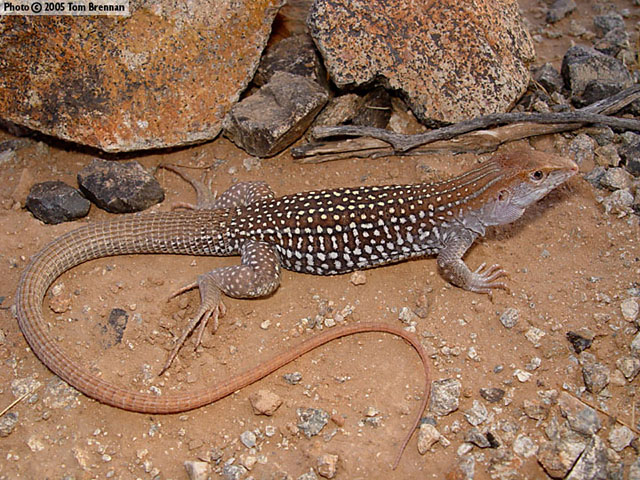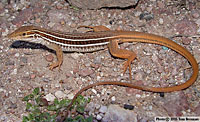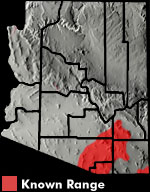Online Field Guide to The Reptiles and Amphibians of Arizona



Large Adult. Pima County, AZ
 Subadult. Santa Cruz Co., AZ |
| CANYON SPOTTED WHIPTAIL Aspidoscelis burti | |
|
DESCRIPTION: The largest whiptail lizard in the United States (up to 140 mm or 5.5″ from snout to vent). It is a slim, reddish brown lizard with a long, thin tail, and a slim, pointed snout. The head, neck, and tail are reddish orange. Young animals have six or seven distinct, light colored stripes on the neck and body. As males age the stripes often begin to break up into spots and additional spots begin to emerge from the dark spaces between the stripes. In some populations large adult males are spotted and lack stripes entirely. The scales on the body are small and granular. The scales on the tail are large, keeled, and rectangular. The scales on the belly are large, smooth, and rectangular. The scales on top of the head are large, smooth, and plate-like. The similar looking Sonoran Spotted Whiptail is smaller, retains its striped pattern into adulthood, and usually does not have an orange tail. The similar looking Red-backed Whiptail has distinct orange coloration on the lower back (but not on the sides), does not have reddish-orange coloration on the neck, and has blue tinting on the limbs. HABITAT: Primarily an inhabitant of the Semidesert Grassland and Madrean Evergreen Woodland communities but also follows drainages down into Arizona Upland Sonoran Desertscrub and Chihuahuan Desertscrub in some areas. Usually encountered along canyons and drainages within mountainous terrain but in some parts of its range it encountered along riparian corridors in low valleys. BEHAVIOR: This is an alert, fast-moving, ground-dweller that actively forages during the day. It hibernates during the cold months of winter and late fall. It is extremely wary and quick to flee when encountered. When pursued it is very conscious of its proximity to the pursuer and often stays just out of reach. It may flee into a burrow or under a fallen log or plant debris pile when persistently pursued. DIET: This lizard actively forages by digging under logs, wood piles, rocks, and leaf litter for a variety of insects including ants termites beetles, and caterpillars. It also eats a variety of spiders. REPRODUCTION: Mates in spring and lays one or two clutches of eggs in summer. Clutch size ranges from 1 to 10 eggs. By Thomas C. Brennan Brennan, T. C., & A. T. Holycross. 2006. A Field Guide to Amphibians and Reptiles in Arizona. Arizona Game and Fish Department. Phoenix, AZ Degenhardt, W. G., Painter, C. W., and Price, A. H.. 1996. Amphibians and Reptiles of New Mexico. University of New Mexico Press. Albuquerque. Stebbins, R.C. 2003. A Field Guide to Western Reptiles and Amphibians, Third Edition. Houghton Mifflin Company, Boston, MA. |
 |
Visit Partners in Amphibian and Reptile Conservation:


HOME
Copyright © 2023, Arizona Game and Fish Department. All rights reserved.
If you make use of the textual contents of this site in reports, publications, etc. please cite and credit the author(s) and photographer(s). All photos on this website are copyrighted. However, those found in the species account section may be used for any noncommercial scientific, educational, or conservation purposes provided that photographs are not altered and continue to bear the copyright symbol and name of the photographer. Please contact the photographer regarding commercial use of copyrighted photographs.









